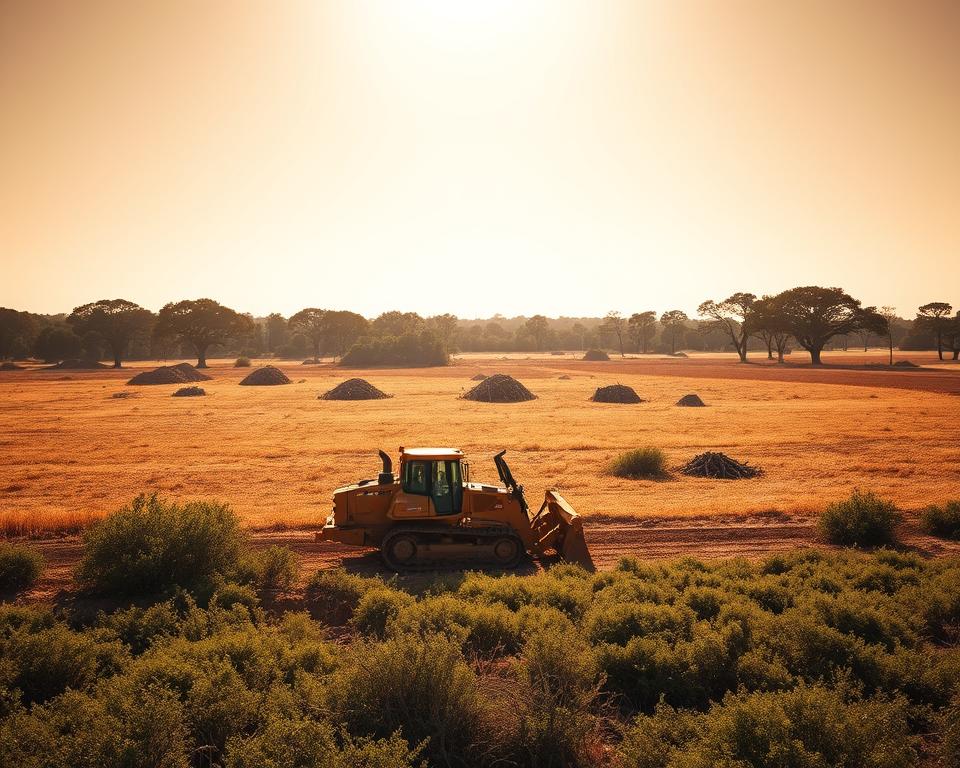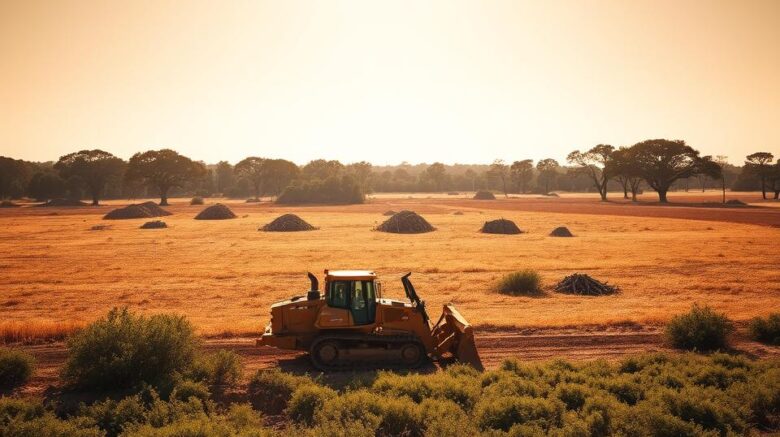Land Clearing Surrounding Water Sources: Optimal Methods
Little-known fact: nearly roughly seven in ten of the global fresh water supplies face risks from farm runoff and Land Clearing? Such a sobering number underscores the pressing requirement for responsible land management, essential during water source Land Clearing. Ensuring environmental responsibility is vital for preserving ecosystem equilibrium and protecting water quality and animal habitats. With increasing resource demands from communities, utilizing sustainable land management practices is essential. It helps achieve project goals while preventing soil erosion and reducing pollution risks in aquatic ecosystems – land clearing services near me.
Core Findings
- Implementing sustainable land management is key to defending water quality.
- Adopting optimal practices prevents soil erosion and habitat loss.
- Awareness of environmental impacts is critical for responsible Land Clearing.
- Thoughtful planning boosts project success while preserving ecosystems.
- Applying successful techniques promotes biodiversity in aquatic landscapes.
Understanding the Importance of Sustainable Land Clearing
Land Clearing is more than just removing plants. It has ecological effects of Land Clearing that can damage surrounding regions, especially those near water. Conventional approaches typically lead to soil erosion, habitat disruption, and water contamination. Understanding these effects is crucial to implementing improved land management.
Ecological Effects of Conventional Land Clearing
Typical Land Clearing practices can lead to various environmental challenges. When vegetation disappears, soil erosion occurs, deteriorating soils and sending sediments into water bodies. These sediments pollute water, affecting aquatic ecosystems. It also threatens local wildlife and disrupts the ecosystem’s balance.
Eco-friendly Land Management Alternatives
Adopting sustainable land management practices offers a solution to traditional clearing’s problems. Selective clearing, where specific plants are removed, preserves ecosystem balance. Employing erosion control strategies—such as cover cropping—stabilizes soils and safeguards water purity. Emphasizing indigenous vegetation bolsters wildlife and fosters ecological well-being.
Key Best Practices for Land Clearing
Successful Land Clearing starts with a deep understanding of environmental factors. Assessing environmental objectives is critical to guarantee clearing efforts are sustainable and impactful. By setting clear objectives, landowners can make decisions that balance environmental preservation with development needs.

Measuring Environmental Aims
Before starting any clearing project, it’s essential to assess environmental goals. This involves evaluating the local ecosystem and how clearing might affect wildlife, soil, and water. Clarifying individual goals supports designing tactics to shield local habitats and watersheds.
Timing Your Clearing Efforts
Choosing the right time for Land Clearing is critical. Winter to early spring, with frozen conditions, lessens soil disruption and erosion risk. Avoiding clearing at wrong times promotes healthier terrains and reduces ecological harm.
Reviewing Local Regulations and Permits
Following local Land Clearing regulations is necessary for successful projects. Familiarity with permits sidesteps legal issues and fines. Reviewing local laws, especially near protected zones, prevents environmental mishaps due to unauthorized clearing.
Land Clearing By Aquatic Points: Best Techniques
Clearing strategies around aquatic sources emphasize safeguarding sensitive zones and preserving ecological equilibrium. This comprehensive method entails pinpointing areas needing extra care and applying suitable erosion control measures. Such actions are vital to conserving biodiversity and water quality.
Recognizing Zones Requiring Protection
Prior to Land Clearing, evaluating the terrain for sensitive sites—like wetlands and riparian strips—is crucial. These zones act as natural filters and refuges for multiple species. By properly identifying these areas, land managers can devise strategies for protecting sensitive areas during and after the clearing process.
Enforcing Erosion Mitigation Measures
After locating sensitive zones, one should apply robust erosion control to reduce sediment flow into nearby waters. Methods like silt fences, vegetative buffers, and cover cropping are key to preserving water purity. Integrating eco-friendly clearing with erosion management nurtures healthier aquatic environments. This ultimately benefits both the environment and local communities.
Comparing Mechanical and Manual Clearing
Choosing between mechanical and manual Land Clearing methods is critical. Each has its own set of advantages and disadvantages, affecting the environment and the clearing process’s efficiency. Understanding these differences helps landowners make informed decisions, aligning with their land management goals.
Mechanical Clearing: Benefits and Drawbacks
Mechanical Land Clearing employs heavy machinery to swiftly remove trees, shrubs, and debris. This method accelerates projects and lowers labor demands. Yet, machinery use can cause significant soil disturbance, compaction, and damage to ecosystems.
- Benefits: Rapid clearing of expansive zones.
- Decreased labor requirements.
- Ability to handle tough terrain.
- Drawbacks: Increased environmental impact.
- Possibility of increased erosion.
- Risk of habitat destruction.
Benefits of Manual and Selective Clearing
Manual, selective clearing prioritizes ecological preservation. Using trained workers, targeted removal reduces soil disruption and safeguards vegetation. Such practices are preferred for biodiversity conservation and ecosystem well-being.
- Benefits: Preservation of native vegetation.
- Lowered soil disturbance and erosion rates.
- Improved wildlife habitat preservation.
Methods for Wetland Clearing
Wetland ecosystems are distinctive habitats vital for ecosystem stability. They purify water, mitigate flooding, and serve as habitats for diverse life forms. Comprehending wetland function underpins responsible clearing. The goal is to minimize disruptions and preserve these vital aquatic habitats.
Understanding Wetland Ecosystems
Wetland ecosystems are characterized by their unique hydrology, soil types, and vegetation. They are transitional areas between land and water, hosting diverse fauna. These ecosystems are essential for water quality regulation, providing natural filtration processes that remove pollutants. Protecting these zones supports biodiversity and strengthens ecosystem resilience.
Methods for Eco-friendly Wetland Clearing
Responsible wetland clearing requires careful planning and execution. Techniques that promote ecological sustainability can mitigate the negative impacts of Land Clearing. Some commonly adopted strategies include:
- Staged Clearing: Conduct clearing in phases to minimize ecological disruption, allowing time for wildlife to adapt.
- Targeted Clearing: Remove only specific vegetation types, preserving critical species for habitat stability.
- Regrowth Practices: Introduce practices that encourage natural vegetation regrowth after clearing, maintaining ecosystem functions.
- Establishing Buffer Areas: Establish buffer areas around sensitive wetland sections to protect aquatic habitats from disturbances.
Using these methods guarantees that wetland clearing respects wetland functions and decreases habitat loss risk.
Riparian Reserve Protection Strategies
Riparian reserves are vital for maintaining healthy aquatic ecosystems. Positioned beside rivers and streams, these zones function as protective buffers. They maintain water purity and foster biodiversity. By adopting best practices, land managers can prevent erosion, protect wildlife habitats, and preserve waterway ecological integrity.
Riparian Buffer Functions
Riparian zones play a vital role in aquatic ecosystems. They filter pollutants, stabilize shorelines, and provide habitats for various species. They serve as barriers that lessen human impact on aquatic systems. Protecting riparian areas enhances water quality, supports fish populations, and strengthens ecosystem resilience.
Riparian Zone Management Tips
To keep riparian reserves effective, several best practices are essential:
- Avoid construction within buffer strips to minimize disturbance.
- Use native vegetation to stabilize banks and prevent erosion.
- Establish a diverse plant community to enhance habitat complexity and support wildlife.
- Manage invasive species to protect native plants and maintain ecosystem stability.
- Regularly assess soil health and water quality to guide management efforts.
Significance of Aquatic Land Clearing Strategies
Aquatic clearing strategies help maintain ecosystem harmony and water quality. Effective water quality management during clearing reduces pollution risks and promotes sustainability. These strategies prevent sediment runoff and improve aquatic ecosystem health.
Evaluating Water Quality and Sediment Control
Effective water quality management starts with assessing local water bodies. Land clearing near these areas must prevent sedimentation, which harms water quality and aquatic life. Strategies include:
- Establishing buffer zones to filter pollutants
- Using sediment traps and barriers to minimize runoff
- Selecting clearing times to coincide with low water levels
These practices shield water quality and sustain ecosystem health. Retained vegetation helps control sediments and cycle nutrients, resulting in healthier water systems.
Promoting Biodiversity in Aquatic Landscapes
Protecting biodiversity around water sources ensures ecosystem robustness. Aquatic land clearing should preserve native species, which are vital for these habitats. Practices to enhance biodiversity include:
- Conserving critical habitats during clearing processes
- Implementing phased clearing to allow wildlife adaptation
- Restoring natural vegetation post-clearing to enhance habitat
Using these approaches helps land managers cultivate biodiversity in aquatic zones. These actions yield stronger, more adaptable ecosystems. Such measures defend water quality and encourage sustainable land management.
Stream Bank and Riverbank Clearing Considerations
Stream bank clearing presents specific challenges that demand ecological and regulatory consideration. Respecting riverbank guidelines is vital to maintain water source ecosystem balance. Addressing erosion, habitat disruption, and water contamination requires targeted solutions.
Obstacles in Stream Bank Clearing
Stream bank clearing faces numerous hurdles. Erosion poses significant risks, leading to soil depletion and declining water quality. Disturbing habitats affects wildlife reliant on riparian areas. Without plants, stormwater runoff surges, depositing sediments in watercourses. These challenges underline the necessity of strategic stream bank management.
Erosion Mitigation and Flora Support
Mitigating erosion is key for stream bank clearing. Using indigenous vegetation fortifies banks. Root systems reduce erosion, promoting a sustainable habitat for local plants and wildlife. Regular assessments during clearing ensure methods are effective, keeping riverbank considerations central to environmental care. Robust vegetation aids land management and preserves ecological integrity.
To Summarize
Implementing the best practices for Land Clearing around water sources is essential for maintaining ecosystem health. Stakeholders need to prioritize sustainable land management. This method accomplishes objectives and defends natural resources. Careful planning and execution ensure Land Clearing operations safeguard aquatic ecosystems and preserve biodiversity.
Spotting vulnerable areas and employing erosion measures are crucial steps. Using mechanical and manual methods enables landowners and contractors to practice responsible land management. Eco-friendly practices promote a balance between human activities and nature. This keeps water sources and nearby landscapes healthy and robust.
Sustainable land management demands collective commitment. Each clearing activity influences watershed health. By adopting eco-friendly methods, we enable a future where farming and environments thrive together.
